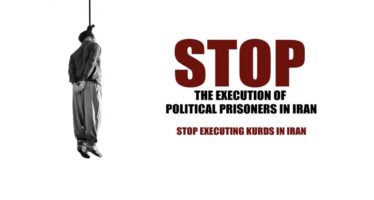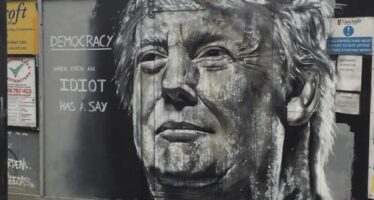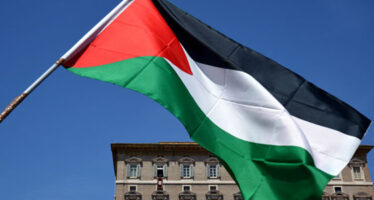Dennis Banks, American Indian Movement (A.I.M.) Leader, Dies…

![]()
Dennis Banks, one of the original founders of the American Indian Movement (A.I.M.) in 1968, has died at the Mayo Clinic in Rochester, Minnesota, USA. He was 80 years old. He died of complications from pneumonia on October 29, following open heart surgery the week before.
Born in poverty on the Leech Lake Indian Reservation in northern Minnesota, of the Ojibwa Tribe, (also known as the Chippewa), on April 12, 1937 and raised by his grandparents, Banks grew up impoverished “in a home with no electricity, running water or indoor plumbing.” When he was 5, he was taken from his family and sent to a series of government schools for Indians that attempted to erase his Ojibwa (Chippewa) culture, language and identity. “My teachers … had made me into an ‘apple’—red outside but white inside,” he was to write later in his autobiography. He ran away often, until, at the age of 17, he returned to Leech Lake.
In 1966, Banks was arrested and sent to prison after stealing groceries to feed his family, he later wrote in his memoir.
The American Indian Movement was founded in 1968 – to fight for indigenous rights and against the oppression and endemic poverty suffered by Native Americans. He became chairman and national director of the group, based in Minneapolis. The Movement grew rapidly. After two years it claimed to have 25,000 members.
Banks and AIM organised a number of high profile protests in the 1970’s:
– 1969–1971, the occupation of Alcatraz Island, (initiated by Indian students from San Francisco of the Red Power movement), which was intended to highlight Native American issues and promote Indian sovereignty on their own lands.
– In 1972, he assisted in the organization of AIM’s “Trail of Broken Treaties”, a caravan of numerous activist groups across the United States to Washington, D.C. to call attention to the plight of Native Americans.
After a protest in Custer, South Dakota, in 1973, where “after a white man killed an Indian in a saloon brawl and was charged not with murder but with involuntary manslaughter” Dennis Banks said:
“We had reached a point in history where we could not tolerate the abuse any longer, where mothers could not tolerate the mistreatment that goes on on the reservations any longer, where they could not see another Indian youngster die...” (quoted in the New York Times)
Banks also organised the siege at Wounded Knee where he led an armed 71-day occupation of the town of Wounded Knee, South Dakota, on the Pine Ridge Reservation; a protest against tribal officials accused of corruption and the U.S. Bureau of Indian Affairs. Wounded Knee was the scene of the last major conflict of the ‘American Indian Wars’, in which an estimated 350 Lakota children, women and men were massacred by United States cavalry in 1890.
“200 Oglala Lakota and A.I.M. followers with rifles and shotguns occupied Wounded Knee. About 300 United States marshals, F.B.I. agents and other law-enforcement officials cordoned off the area with armored cars and heavy weapons, touching off a 10-week battle of nerves and gunfire.”
The occupation ended after a siege of 71 days by armed federal law enforcement, which received national attention. A U.S. marshal was shot and paralyzed in March. A Cherokee and an Oglala Lakota were shot to death in April 1973, and civil rights activist Ray Robinson, who joined the protesters, disappeared during the occupation and is believed to have been murdered.
Banks was the principal negotiator and leader of the Wounded Knee forces.
As a result of involvement in the Custer and Wounded Knee protest, Banks and 300 others were arrested and faced trial. He was acquitted of the Wounded Knee charges, after a judge dismissed the case for prosecutorial misconduct, including illegal wiretaps and evidence that had been tampered with but he was convicted of incitement to riot and assault stemming from the earlier confrontation at Custer.
In 1975 facing up to 15 years in prison, he jumped bail and fled to California.
With 1.4 million signatures on a petition supporting him, Governor Jerry Brown granted him asylum in 1976, rejecting extradition to South Dakota by saying his life might be in danger if he were sent back. His safe refuge, though, was not to last. In 1983 Brown was succeeded by a Republican, George Deukmejian, and Dennis Banks sought sanctuary on an Onondaga reservation near Syracuse. Federal officials said he would be arrested only if he left the reservation. But in 1984, weary of his confined life, he returned to South Dakota voluntarily and was sentenced to three years in prison.
In 1985 after serving only 14 months, he moved to work on the Pine Ridge Reservation.
In 2004, in Ojibwa Warrior, written with the writer and photographer Richard Erdoes, Banks told his own story for the first time and also traced the rise of the American Indian Movement.
In later years Dennis Banks was the 2016 vice presidential nominee of the California Peace and Freedom Party, which identified itself as socialist and feminist. The party’s presidential candidate was Gloria La Riva. As a single-state ticket, they won 66,000 votes.
“Our father Dennis J. Banks started his journey to the spirit world … on Oct. 29, 2017,” his children and grandchildren said in a statement. “All the family who were present prayed over him and said our individual goodbyes.” (Reuters)
He ends his 2004 memoir:
“Every day we receive calls of distress, and every day we offer tobacco ceremonies for those in need. Right now this earth, our mother, is in distress. She needs our help. Can we-all of us-respond? I don’t know, but I am convinced that if we don’t respond, we will be in peril and our future will lay in question. Today I look around me and see the animals of the forests and lakes. Every day, eagles fly by our home overlooking Leech Lake, and to the eagles, the bears, and the porcupines, I say me-gwitch for a good life.
Me-gwitch Leonard Peltier
Me-gwitch Buddy Lamont
Me-gwitch Annie Mae
Me-gwitch Bug-a-nay-ge-shick
DENNIS BANKS, Anishinabe Territories, Leech Lake reservation, Where the Great Spirit lives”
Dennis Banks, American Indian Civil Rights Activist, April 12, 1937 – October 29, 2017, rest In peace…
séamas carraher
*****
Sources & References:
Image:
By Neeta Lind, via flickr
Creative Commons, Attribution 2.0 Generic (CC BY 2.0)
https://creativecommons.org/licenses/by/2.0/Wounded Knee AIM veterans
Front Row, L-R: ? Casey Camp-Horinek, Carter Camp, Duane Camp, Richard Whitman
Back Row, L-R: Don Patterson, Dennis Banks, Craig Camp, Sr., ?, ?, Bear aka Sugar Bear, ?
References:
https://en.wikipedia.org/wiki/Dennis_Banks
Dennis Banks (with Richard Erdoes), ‘Ojibwa Warrior, Dennis Banks and the Rise of the American Indian Movement’, University of Oklahoma Press, 2004.
Video:
1970s Dennis Banks Interview, San Francisco, Native American
Kinolibrary Archive Film collections.
AIM “Wooden Indians No More”
Wounded Knee 1973: An Inevitable Outcome – Part I
“This is part I of a short documentary surrounding the causes of the occupation of Wounded Knee in 1973. Modern Native American history largely goes unmentioned and is briefly discussed. ”
Related Articles
Ramin Hossein Panahi, Iranian Kurd, to Die…
![]()
Prison officials summoned Ramin Hossein Panahi on 19 May informing him that his execution will be carried out after 15 June, when the Muslim month of Ramadan ends
Las supuestas “disculpas” de Israel a México por el tweet de Benjamin Netanyahu apoyando el muro entre México y Estados Unidos
![]()
el Presidente de Israel mantuvo una conversación telefónica con su homólogo mexicano, con el fin de limar las tensiones creadas entre ambos Estados
Asamblea General de Naciones Unidas aprueba izar bandera de Palestina
![]()
El pasado 10 de septiembre, la Asamblea General de las Naciones Unidas adoptó una resolución mediante la cual la bandera palestina pueden ser izadas en la sede de la organización en Nueva York





